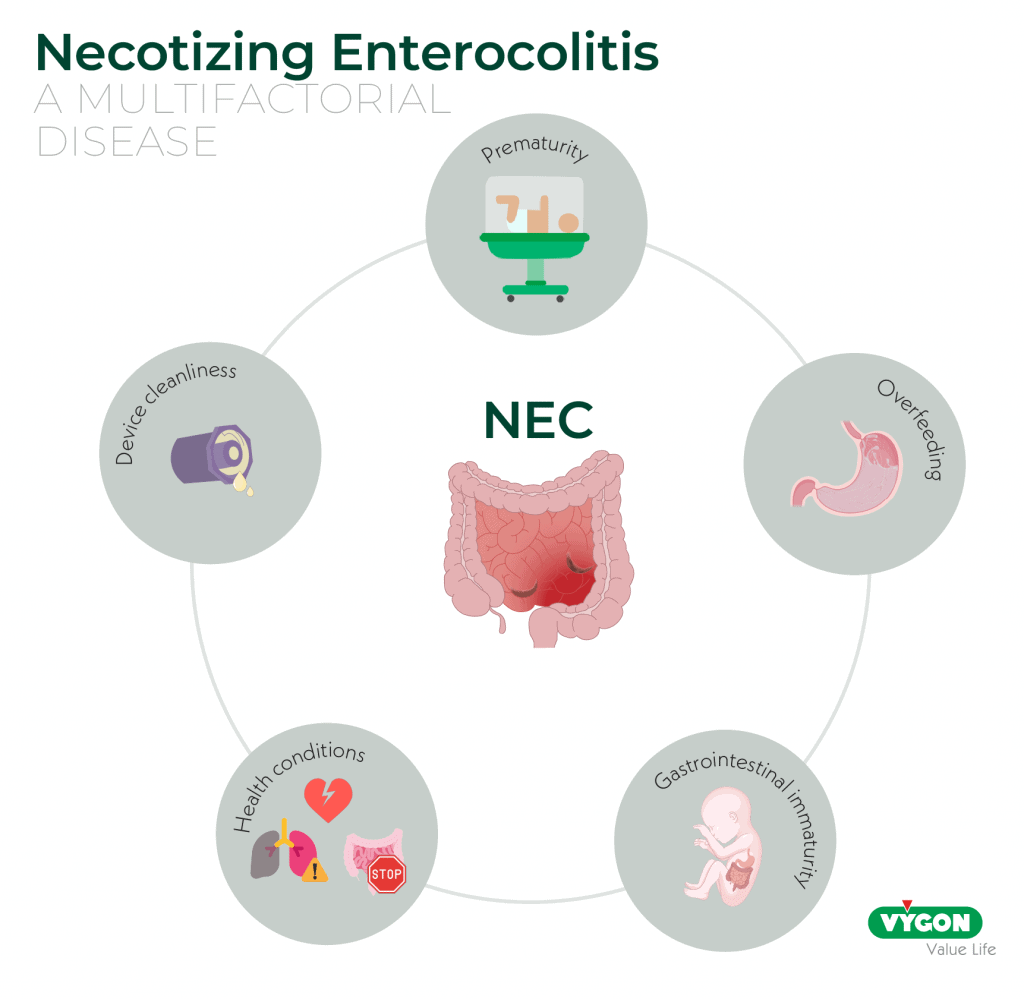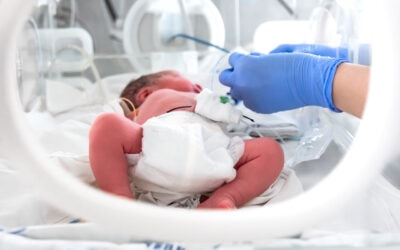Definition of NEC
Necrotising enterocolitis (NEC) is a serious condition that can occur following preterm birth, characterized by bowel inflammation that prevents milk feeding and may require surgery. It is associated with high mortality rates, exceeding 20%. The incidence of NEC is highest in neonatal intensive care units (NICUs) and is more common in babies of lower gestational ages1.
A Multifactorial Disease
NEC is considered a disease with a multifactorial etiology, involving factors such as immature intestinal, immune systems, hypoxia, disrupted microbiome, as well as the use of certain medications, mode of delivery, and nutrition2.

Prematurity
Prematurity is the most significant risk factor for NEC. Infants born before 32 weeks of gestation have underdeveloped cardiac, respiratory, gastrointestinal, and immune systems, making them particularly vulnerable3. The immature gut is characterized by reduced peristalsis, a thin mucous layer, and increased permeability, which may facilitate bacterial translocation and inflammation.
Enteral nutrition
Rapid or large-volume introduction of enteral feeds can increase the risk of NEC4. Although enteral feeding is crucial for the neurological development of premature infants, it can disrupt the intestinal microbiome, reducing microbial diversity and promoting the overgrowth of pathogenic bacteria. This is particularly true when infants are fed with formulas based on cow’s milk rather than human milk, which has been shown to have protective effects.
Gastrointestinal factors
Gastrointestinal immaturity is a significant risk factor for necrotizing enterocolitis (NEC). The gastrointestinal tract undergoes development throughout pregnancy, both in terms of tissue growth and functional maturity. When an infant is born prematurely, this development is disrupted, leading to an immature gastrointestinal system. This immaturity is believed to contribute to NEC through a combination of factors, including infection, inflammation, and enteral feeding5. The immature gut is less capable of handling enteral feeds, which can lead to inflammation and increase the risk of NEC. A careful management of feeding practices can help reduce the risk of NEC.
Moreover, alterations in the intestinal microbiota have been implicated in NEC. The use of proton pump inhibitors (for the reduction of gastric acid) or H2 blockers can change the intestinal pH, promoting the growth of inflammatory bacteria and leading to mucosal inflammation, which may predispose infants to NEC6.
Health conditions
Several medical conditions and interventions can increase the risk of NEC. These include: cardiac lesions, bowel obstruction, and compromised respiratory function.
Indeed, frequent respiratory issues in premature infants, such as bronchopulmonary dysplasia, further reduce the oxygen supply to organs, including the intestines. Certain vasoconstrictive medications also decrease blood flow to the gut, exacerbating the risk of necrosis.
Device factor
The implementation of ENFit in the NICU may unintentionally raise the incidence of necrotizing enterocolitis (NEC) due to the design of the connectors, which can hinder proper cleaning and heighten the risk of microbial colonization and contamination7.
Conclusion
Necrotizing enterocolitis remains a significant challenge in the care of premature infants. Although the exact causes of this disease are not fully understood, better management practices and careful medical monitoring can help reduce the incidence and severity of NEC. Continued research is essential to further elucidate the underlying mechanisms and improve prevention and treatment protocols for at-risk infants.
Bibliography
- National Neonatal Audit Programme. (2024). National Neonatal Audit Programme 2023 Data: Extended Analysis Report. Royal College of Paediatrics and Child Health.
- Christian, V. J., Polzin, E., & Welak, S. (2018). Nutrition management of necrotizing enterocolitis. Nutrition in Clinical Practice, 33(4), 476-482.
- Shulhan, J., Dicken, B., Hartling, L., & Larsen, B. M. (2017). Current knowledge of necrotizing enterocolitis in preterm infants and the impact of different types of enteral nutrition products. Advances in nutrition, 8(1), 80-91.
- Shulhan, J., Dicken, B., Hartling, L., & Larsen, B. M. (2017). Current knowledge of necrotizing enterocolitis in preterm infants and the impact of different types of enteral nutrition products. Advances in nutrition, 8(1), 80-91.
- Christian, V. J., Polzin, E., & Welak, S. (2018). Nutrition management of necrotizing enterocolitis. Nutrition in Clinical Practice, 33(4), 476-482.
- Terrin, G., Passariello, A., De Curtis, M., Manguso, F., Salvia, G., Lega, L., … & Canani, R. B. (2012). Ranitidine is associated with infections, necrotizing enterocolitis, and fatal outcome in newborns. Pediatrics, 129(1), e40-e45.
- Girgenti, C., & Hyde, J. (2024). Understanding Feeding Tube Risks Associated with Necrotizing Enterocolitis






